Double Stroller Buying Guide: Top 5 Essential Tips 2025
Navigating Your Double Stroller Journey
If you’re searching for a double stroller buying guide, you’re likely feeling overwhelmed by the countless options available. Here’s a quick overview to help you make an informed decision:
| Key Consideration | What to Look For |
|---|---|
| Stroller Type | Side-by-side, tandem, convertible, or wagon |
| Weight & Size | Folded dimensions, weight (typically 18-40 lbs) |
| Maneuverability | Wheel type, turning radius, suspension |
| Age Compatibility | Newborn features, weight limits (typically up to 50 lbs per seat) |
| Price Range | Budget ($150-300), mid-range ($300-700), premium ($700+) |
Choosing the right double stroller is much like finding the perfect family car – it’s an investment that needs to match your lifestyle, space constraints, and daily activities. Whether you’re expecting twins, preparing for a second child, or simply need a solution for transporting two little ones, the right stroller can make the difference between stress-free outings and transportation nightmares.
“Double strollers are an investment, but crucial to getting out when you have two (or more) kids close in age,” note parenting experts who’ve surveyed thousands of families about their stroller experiences.
The choice between side-by-side models (where children sit next to each other) and tandem designs (where one child sits behind the other) isn’t just about width – it affects everything from how your children interact to how easily you can steer doorways and store the stroller in your trunk.
I’m James Mark, a baby gear specialist with over 8 years of experience testing and reviewing strollers, and I’ve created this double stroller buying guide to help you steer this important decision without losing your mind. Let’s break down the essentials so you can find the perfect double stroller for your growing family.
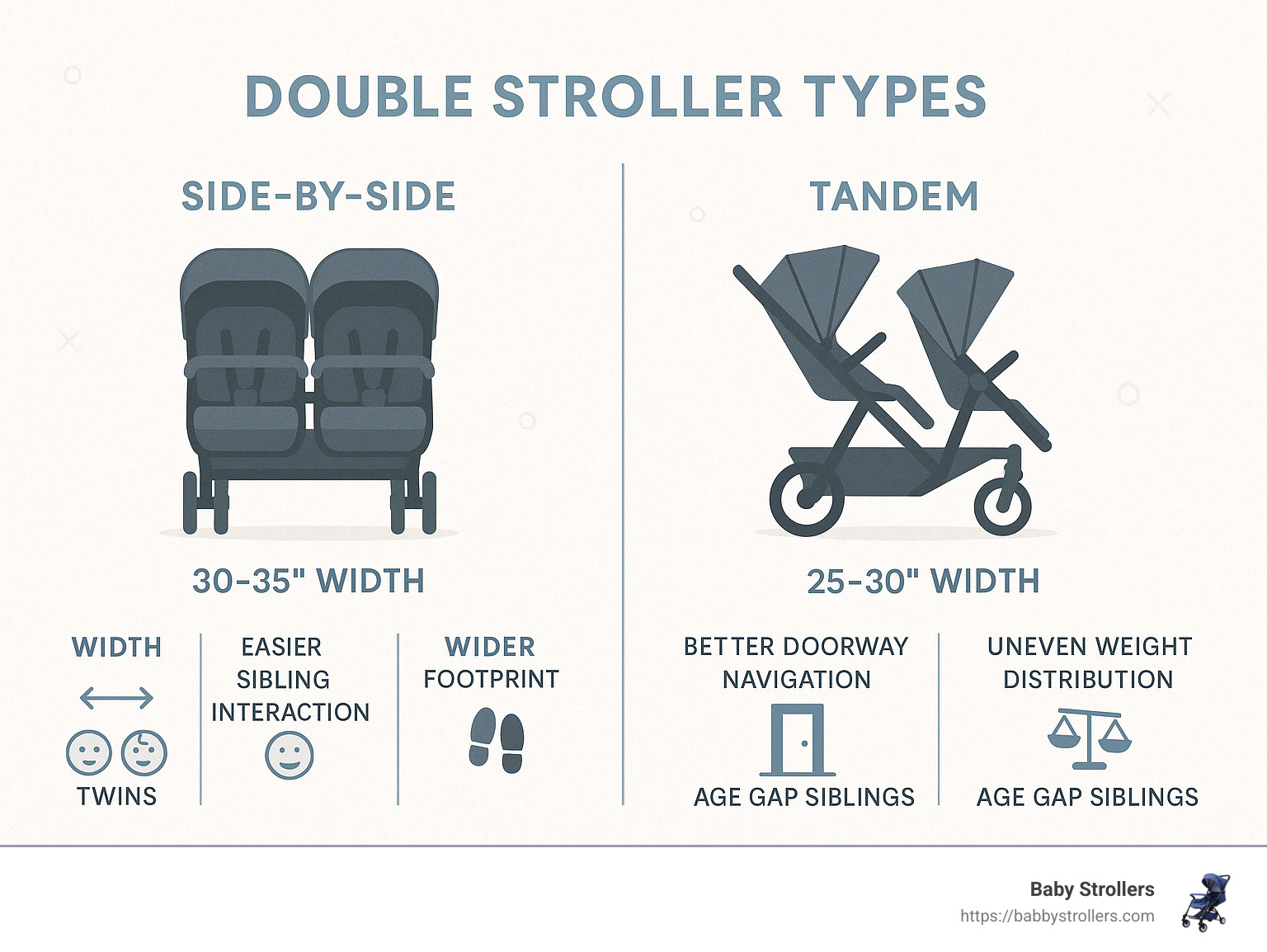
Double stroller buying guide further reading:
Why Choose a Double Stroller
“I honestly don’t know how we would have survived the first three years without our double stroller,” confessed Maria, a mother of twins I spoke with recently. Her words reflect what I’ve heard from countless parents facing the beautiful chaos of raising multiple young children.
For many families, a double stroller buying guide is something they search for not as a luxury purchase, but as an essential survival tool. When you have two little ones who can’t walk far (or at all), a quality double stroller becomes the difference between freedom and confinement.
The benefits of investing in a good double stroller extend far beyond the obvious:
Reclaiming your mobility is perhaps the most immediate reward. Remember those spontaneous walks to the park or quick trips to the grocery store? With a double stroller, they don’t have to become distant memories. Parents can maintain their active lifestyle without being limited by a toddler’s unpredictable walking pace or a baby’s need to be carried.
Safety becomes simpler when both children are secured in one unit. As one dad told me, “Trying to hold my toddler’s hand while pushing my infant in a single stroller near traffic gave me constant anxiety.” A double stroller keeps everyone contained and protected, especially in crowded or potentially dangerous environments.
The logistics make sense. As Jenny, mother of children 15 months apart, laughed while telling me, “Someone suggested I just use two separate strollers. I asked them if they’d also like to donate their extra set of arms!” One parent simply cannot manage two separate strollers simultaneously.
Nap schedules stay intact with a double stroller. Both children can recline and rest comfortably when tired, meaning your outings don’t have to end abruptly when one child needs sleep while the other is still raring to go.
Storage space is typically generous on double models. The expanded design usually comes with larger baskets and additional pockets—perfect for carrying diaper bags, snacks, shopping items, and all the mysterious “essentials” that seem to multiply with each child.
The investment holds value longer than you might expect. Today’s double strollers are engineered to support children up to 50 pounds per seat, meaning they can serve your family for many years. Some convertible models even transform from single to double and back again, adapting to your family’s changing needs.
Beyond these practical benefits, there’s something powerful about the freedom a good double stroller provides. It’s about maintaining your family’s connection to the outside world during those intense early years. It’s about preserving your sanity through mobility. It’s about making the challenging journey of parenting multiple young children just a little bit easier.
As one parent eloquently put it in our community forum: “Our double stroller isn’t just baby gear—it’s our ticket to normalcy, trip, and maintaining our identity as a family that doesn’t just stay home all day.”
Whether you’re expecting twins, preparing for a second baby, or already struggling to manage outings with two little ones, a thoughtfully chosen double stroller can transform your daily experience as a parent.
Types of Double Strollers
When diving into your double stroller buying guide research, understanding the four main types is essential. Each configuration offers distinct advantages depending on your family’s specific needs and lifestyle.
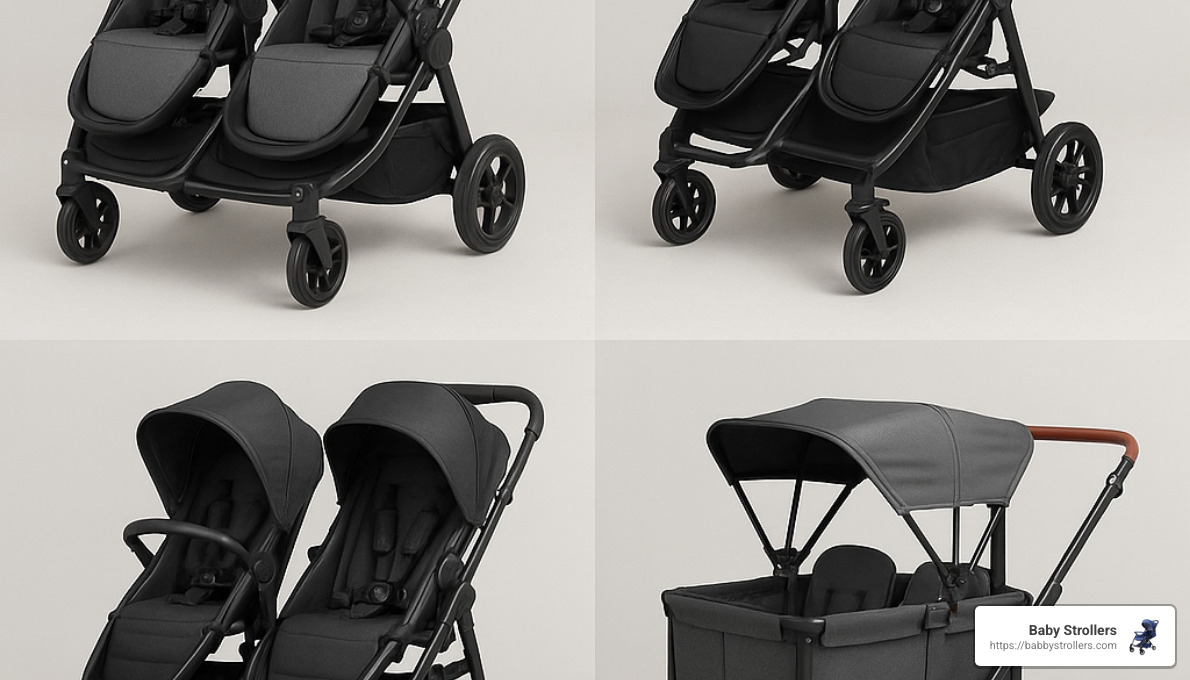
Side-by-Side Strollers
Picture this: two little ones sitting next to each other, giggling and sharing snacks as you stroll through the park. That’s the charm of side-by-side double strollers. These models place both seats adjacent to each other, creating a wider but typically more maneuverable option.
The beauty of side-by-side designs lies in their equality. Both children enjoy identical views and seating positions, which can significantly reduce sibling squabbles about who gets the “better” seat. The weight distribution is naturally balanced, making these strollers surprisingly easy to push and turn.
“The Bugaboo Donkey 5 Duo’s side-by-side seating configuration makes it so much easier to steer two toddlers compared with a tandem setup,” one parent told me after switching from a tandem model.
These strollers typically feature fully-functional seats with equal recline capabilities, perfect for synchronized nap times. However, their wider profile (usually 29-32 inches) means you’ll need to be mindful of doorways and narrow spaces. While most modern models like the Baby Jogger City Mini GT2 Double (29.25 inches wide) are designed to fit through standard 36-inch doorways, you might find yourself doing the “stroller shuffle” in tight store aisles.
Tandem Strollers
Tandem strollers solve the width problem by positioning one seat behind the other. Think of them as the “city-friendly” option in your double stroller buying guide search. With a width similar to single strollers (typically 21-24 inches), they slip through doorways and steer crowded spaces with ease.
“I call it my truck,” one mom joked about her tandem model, highlighting their longer, more substantial feel. This design makes them ideal for urban environments and public transportation where space comes at a premium.
The trade-off? Turning can require a bit more muscle due to their length, and the child in the rear seat might have a more limited view. Weight distribution can also affect pushing ease, especially if you have children of significantly different sizes.
Many parents appreciate that tandem models like the UPPAbaby Vista V2 and Graco DuoGlider fold more compactly than their side-by-side counterparts, making them easier to stash in smaller vehicle trunks. Just be aware that in many designs, the back seat has limited recline when both seats are occupied – something to consider if your little ones nap on the go.
Convertible Double Strollers
Think of convertible strollers as the “future-proof” option in your stroller search. These clever designs start as single strollers and expand to accommodate a second child when your family grows.
“We can easily use it as a single or a double depending on how my oldest is feeling on any given day,” shared one parent who invested in a Mockingbird Single-to-Double 2.0. This flexibility allows you to adapt to changing needs without purchasing multiple strollers.
The modular design of convertibles like the Baby Jogger City Select offers up to 20+ different seating configurations. Your children can face you, face forward, face each other, or even ride in a mix of car seats, bassinets, and regular seats. This versatility is particularly valuable when you have children of different ages with different needs.
While convertibles tend to be heavier and sometimes more expensive initially, many parents find them to be cost-effective long-term investments. The learning curve for reconfiguring them can be steeper, but most parents master the changes quickly after a few practice runs.
Stroller Wagons
The newest kid on the block in the double stroller buying guide world is the stroller wagon – a brilliant hybrid that blends traditional wagon fun with practical stroller features. If you’ve ever seen children excitedly climbing into what looks like a fabric-sided off-road vehicle at the zoo or beach, you’ve spotted one of these innovative designs.
Stroller wagons offer a spacious seating area where children can move around rather than being strapped into fixed positions. This freedom of movement can be a game-changer for active toddlers who resist traditional stroller confinement. Many models like the Evenflo Pivot Xplore position children facing each other, encouraging interaction and play.
“Our wagon stroller saved our sanity on our beach vacation,” one dad told me. “The big wheels rolled easily on sand, and there was room for all our gear underneath.” This generous storage capacity makes wagons excellent for outdoor trips and all-day excursions.
The downside? They’re bulkier and heavier than traditional strollers, and some venues (particularly theme parks) have specific policies about whether they accept wagons as strollers. They also typically require additional accessories for infant use, so they’re best suited for families with toddlers and older children.
While each type offers distinct advantages, the best choice depends on your family’s unique lifestyle, the ages of your children, and where you’ll use your stroller most often. Taking the time to understand these fundamental differences will help narrow your options as you continue your search for the perfect double stroller.
Double Stroller Buying Guide: Key Features to Consider
Once you’ve determined which type of double stroller best suits your family’s needs, it’s time to evaluate specific features that will impact your daily use and satisfaction. As a parent juggling two little ones, these details can make the difference between a stroller you love and one that collects dust in your garage!
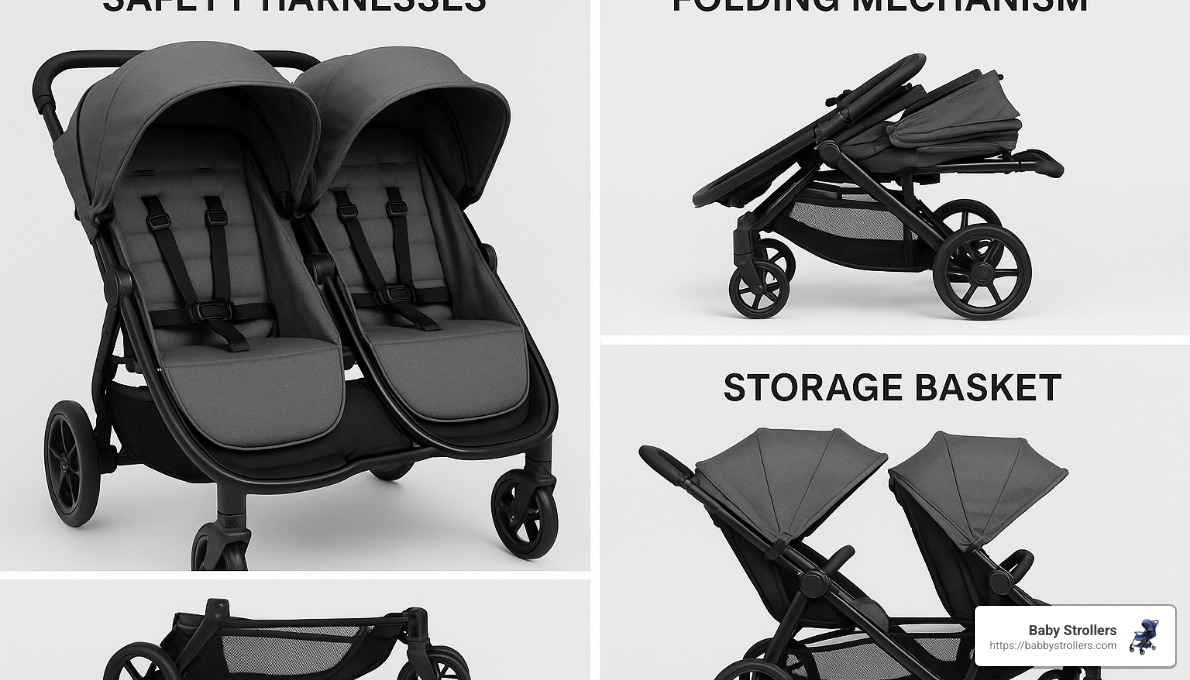
Safety Considerations in Your Double Stroller Buying Guide
Safety should always be your top priority when selecting any baby gear, especially something as fundamental as a stroller.
When I evaluate strollers with parents, the first thing we check is the five-point harness systems. Every seat should include a secure harness that restrains your child at the shoulders, hips, and between the legs. These aren’t just an annoying thing to buckle – they’re essential for preventing curious toddlers from standing up or sliding out while you’re in motion (and trust me, they’ll try!).
The braking system is another non-negotiable feature. Look for models with easy-to-engage, flip-flop-friendly brakes that lock both rear wheels simultaneously. Nothing’s worse than trying to lock a stroller while balancing on one foot in summer sandals! During our testing, we evaluate brakes for reliability on inclines – that coffee shop with the sloped patio won’t be so stressful when you know your brake will hold.
Frame stability becomes even more crucial with two passengers. A well-designed double stroller prevents tipping, particularly important with the potentially uneven weight distribution of two children. As one mom told me, “My toddler likes to lean way over to see her baby brother, and I need to know the stroller won’t tip!”
Don’t overlook pinch points protection – quality double strollers include protective measures to prevent little fingers from getting caught in folding mechanisms or hinges. And always check that any stroller you consider meets current safety standards from organizations like ASTM and JPMA.
As one parent noted during our testing: “Safety features like the automatic lock when folding and the red/green indicators on the car seat attachments gave me peace of mind. With twins, I need all the mental bandwidth I can get!”
Weight and Size Considerations in Your Double Stroller Buying Guide
The weight and dimensions of a double stroller significantly impact its practicality for everyday use. This is where theory meets reality – a beautiful stroller that you can’t lift into your trunk isn’t going to work for long!
Overall weight can vary dramatically between models. Lightweight options like the Delta Children LX Side by Side weigh as little as 18.5 pounds, while full-featured models like the UPPAbaby Vista V2 tip the scales at 36.5 pounds. Consider who will be lifting and transporting the stroller regularly – that extra weight matters when you’re hoisting it up stairs or into a car trunk.
One petite mom shared with me: “After losing a couple of pounds and a couple of inches, the newest version of the G-Link double umbrella is much more manageable for daily use. I can actually lift it myself now!”
Folded dimensions can make or break your stroller experience. Those measurements (typically provided as length × width × height) directly determine whether your stroller will fit in your vehicle. I always recommend grabbing a measuring tape and checking your trunk space before purchasing. The Silver Cross Wave folds to 37″ L × 23″ W × 15″ H, while the Bugaboo Donkey 5 Duo comes in at 35″ L × 23.6″ W × 13.8″ H – those few inches can make all the difference!
Don’t forget to consider unfolded dimensions too. Side-by-side models typically range from 29-32 inches wide, while tandem models are narrower (typically 21-24 inches) but longer. I’ve watched too many parents struggle to steer narrow doorways or tight store aisles with an oversized stroller.
The folding mechanism itself deserves special attention. With a double stroller’s larger size and weight, an intuitive, smooth folding process is invaluable. Look for one-handed folding capabilities (because your other arm will likely be holding a child), self-standing when folded (to keep it clean in parking lots), and compact fold design. As one dad joked during testing, “I don’t want to need an engineering degree just to collapse my stroller!”
Car Seat Compatibility
For families with newborns or infants, car seat compatibility is a crucial consideration in your double stroller buying guide research. This feature can save your sanity during those early months!
Travel system functionality allows you to click infant car seats directly onto the stroller frame – a game-changer for transferring sleeping babies from car to stroller without waking them. Trust me, you’ll do almost anything to avoid disturbing a peacefully sleeping newborn!
If you have twins, verify that the stroller can accommodate two infant car seats simultaneously. Not all double strollers offer this capability, which can be a deal-breaker for parents of multiples. One twin mom told me: “Finding a stroller that could hold both infant seats was non-negotiable for us – I wasn’t going to carry one baby while pushing the other.”
Brand compatibility varies widely between models. Some strollers only work with their own brand’s car seats, while others offer adapters for multiple brands. Universal adapters accommodate various car seat brands, while brand-specific adapters are designed for particular models. Some premium strollers include adapters with purchase, saving you $50-100 in additional costs.
I love how one parent of twins emphasized this point: “Right out of the box, the Silver Cross Wave comes with everything you need to get rolling as a single or double,” highlighting the convenience of included adapters. Those “hidden costs” can really add up when you’re already investing in a double stroller!
Comfort and Convenience Features
The daily usability of your double stroller depends heavily on practical features that make life easier for both you and your little passengers.
Independent reclining seats are worth their weight in gold when you have two children with different napping schedules. Nothing’s worse than having to wake a sleeping baby because their sibling wants to sit up and see the world! Fully-reclining seats are essential for newborns if you’re not using car seats or bassinets.
Adjustable footrests improve comfort for children of different heights or ages. This seemingly small feature makes a big difference in how content your children will be during longer outings.
Canopies and sunshades that adjust independently shield children from sun, wind, and light rain. Premium models feature extendable canopies with peek-a-boo windows so you can check on your little ones without disturbing them. One tester noted: “My little one loved the ability to pull the canopy down for privacy,” highlighting how this feature supports napping on the go.
An adjustable handlebar accommodates parents of different heights, reducing back strain during extended use. This feature is particularly valuable when multiple caregivers use the stroller. My husband (6’2″) and I (5’5″) appreciate this feature more than almost any other on our stroller!
Storage options become even more important with two children. Double strollers should offer generous storage given the increased gear required – underseat baskets (capacity ranges from 10-30 pounds), parent organizers for phones and drinks, child trays for snacks, and side pockets for quick-access items like pacifiers or small toys.
Finally, don’t underestimate the importance of wheel quality and suspension. Wheel design significantly impacts maneuverability and ride comfort. Air-filled tires provide the smoothest ride but require maintenance, foam-filled “never-flat” tires offer a good balance of comfort and convenience, and plastic wheels are lightweight but perform poorly on uneven surfaces. A good suspension system absorbs bumps for a smoother ride, preventing those jarring movements that can wake sleeping babies.
As one parent beautifully described during our testing: “The independent suspension allowed for an exceptionally smooth ride through grassy and uneven terrains. My babies didn’t even wake up when we rolled over tree roots at the park!”
Choosing the right double stroller might seem overwhelming at first, but focusing on these key features will help you find the perfect match for your family’s needs. The best stroller is the one that fits your lifestyle, your children’s needs, and your storage space – not necessarily the one with the trendiest brand name or highest price tag!
Tips for Choosing the Best Double Stroller for Your Family
Finding the perfect double stroller isn’t just about picking the most expensive or feature-packed model—it’s about finding the one that feels like it was designed specifically for your family’s unique needs. After testing dozens of models with real families, I’ve finded that the best stroller for you depends on where you live, how you move through the world, and the little passengers who’ll be riding in it.
Assess Your Lifestyle Needs
Your daily environment plays a huge role in which stroller will make your life easier rather than more complicated.
If you’re navigating city life, those narrow sidewalks and crowded buses demand different features than suburban driving. Urban parents should prioritize narrower profiles—think tandem models or the slimmer side-by-sides that can glide through standard doorways without the dreaded “stroller stuck” moment. One mom in Chicago told me, “After getting my stroller wedged in a revolving door, I switched to a tandem model and haven’t looked back!”
For suburban families, your relationship with your car trunk becomes crucial. That gorgeous, full-featured model might look perfect in the store, but if it requires an engineering degree to fold and won’t fit in your crossover’s trunk, you’ll regret it by day three. Take measurements of your trunk space before shopping, and practice that folding mechanism several times in-store.
Outdoor enthusiasts need to think beyond smooth sidewalks. Those beautiful Instagram photos of family hikes require strollers with serious wheels and suspension systems. As one trip-loving dad put it, “We thought any stroller would work for light trails. We were so wrong—our first cheap model was like pushing through quicksand. Our all-terrain model made all the difference.”
For frequent travelers, weight and fold size become your top priorities. A 35-pound stroller might feel manageable at home but becomes a monster when you’re rushing through an airport with luggage and children in tow. Look for models under 23 pounds if possible, with quick, intuitive folding mechanisms.
Consider Your Children’s Ages and Sizes
The age gap between your children significantly impacts which configuration will work best for your family’s dynamics.
With twins or closely-spaced siblings (less than 2 years apart), virtually any double stroller configuration can work well. Side-by-side models often shine here because they offer identical seating positions with equal features. No more fighting over who gets the “better” seat!
For children with a 2-4 year age gap, look for strollers with adjustable features that can accommodate different needs simultaneously. Your toddler might want to sit upright and see the world while your infant needs to recline for a nap. One mom of a 4-year-old and 1-year-old shared, “Our convertible model lets my older one hop on and off as he pleases, while keeping my little one secure. It’s saved countless tantrums.”
The newborn-toddler combination requires special consideration. Ensure your chosen model offers safe newborn options (full recline, bassinet attachment, or secure car seat compatibility) while still giving your active toddler the comfort they need. Many parents find models where seats can face different directions particularly helpful during this stage.
Most double stroller buying guide experts recommend checking individual seat weight limits (typically 40-50 pounds each) and total capacity (usually 80-100 pounds) to ensure your stroller will grow with your children.
Set a Realistic Budget
Double strollers range dramatically in price, and understanding what you get at each tier helps set appropriate expectations.
Budget options ($150-300) will get you basic functionality—they’ll hold two children safely and roll from point A to point B. They tend to be heavier, with simpler folding mechanisms and less durable materials. As one practical parent noted, “Our $179 stroller isn’t winning beauty contests, but it does exactly what we need without breaking the bank.”
Mid-range models ($300-700) offer significant improvements in maneuverability, comfort, and convenience. You’ll find better recline options, improved storage space, and more intuitive folding mechanisms. These strollers typically strike a good balance between quality and value.
Premium strollers ($700+) deliver sophisticated engineering, premium materials, and maximum versatility. As one parent eloquently put it about their high-end purchase: “To own him is to love him.” While expensive, these models often offer superior durability and can serve multiple children over several years, potentially making them more economical in the long run if you plan to grow your family.
Accessories can quickly add up: cup holders, snack trays, weather shields, and car seat adapters can add $50-200 to your total investment depending on the brand and model.
Test Drive Before Purchasing
Nothing replaces hands-on experience with a stroller before committing. Whenever possible, test drive potential models in person. Here’s your test-drive checklist:
For maneuverability, push with one hand to test balance, make tight turns to assess turning radius, and try different surfaces if possible. One dad advised, “The stroller that felt amazing on the store’s smooth floor was a nightmare on our neighborhood’s uneven sidewalks.”
Practice folding and unfolding several times—what seems intuitive in a demonstration can feel puzzling when you’re doing it yourself. Check if it stands when folded (a back-saver when you’re loading the car) and lift it to gauge the actual weight.
Test all adjustable features like seat reclines, canopies, footrests, and the handlebar height. A stroller that works perfectly for a 5’3″ mom might cause back strain for a 6’1″ dad if the handlebar doesn’t adjust properly.
If possible, bring your children along to test seat comfort, harness fit, and visibility from their vantage point. As one mom finded, “My son rejected three strollers we loved because he couldn’t see out properly from his position.”
Finally, if you’ll be using infant car seats, bring yours to test compatibility. The ease of attaching/detaching and the stroller’s stability once attached can vary dramatically between models.
A comprehensive scientific research study on stroller safety found that parents who test strollers before purchasing report higher satisfaction and fewer safety concerns than those who buy sight unseen.
The perfect double stroller buying guide is the one that makes your specific family’s daily life easier. A stroller that works beautifully for your sister’s family might be all wrong for yours—and that’s perfectly okay. The best double stroller is the one that feels like it was designed with your unique family in mind.
Frequently Asked Questions about Double Strollers
At what age can my child start using a double stroller?
When parents ask me about age limits for double strollers, I always tell them it’s less about age and more about developmental stages and the specific stroller design. Most double strollers can accommodate children from birth through around age 5 (or up to 50 pounds per seat), but there’s more to consider.
For those tiny newborns (0-6 months), safety is paramount. You’ll need a stroller with either a fully-reclining seat that goes completely flat, a bassinet attachment that creates a safe sleeping surface, or compatibility with your infant car seat. I cannot stress this enough – never place a newborn in an upright stroller seat, as they lack the neck strength to support their heads.
Once your little one reaches the 6-12 month milestone and can sit unassisted (that magical moment usually happens around 6 months), they can typically use a partially reclined seat. Just remember to always use that five-point harness, properly adjusted to their size – I’ve seen too many curious babies try to make escapes!
For your toddlers and preschoolers, most double strollers will continue to serve you well until they reach about 40-50 pounds per seat. Some families with wider age gaps might prefer a sit-and-stand model, which accommodates an older child who wants the option to sit or stand on a platform.
One mom of twins told me, “We used our side-by-side from the hospital through preschool – best investment we ever made!” But remember, always check your specific stroller’s manual for the manufacturer’s recommendations, as weight limits and configurations vary significantly between models.
How do I maintain and clean a double stroller?
Let’s be honest – double strollers get double the mess! After watching countless parents struggle with gunked-up wheels and mysterious stains, I’ve developed a maintenance routine that keeps strollers looking (and smelling) fresher longer.
For regular weekly maintenance, give your stroller’s frame a quick wipe-down with a damp cloth and mild soap. Those little hands leave sticky fingerprints everywhere! Most fabrics can be spot-cleaned as needed, and don’t forget to check and clean the wheels – I’m always amazed at how much hair and debris they collect during just one week of normal use.
About once a month, take a few extra minutes to inspect the harnesses (wiping them clean with a damp cloth) and check for any loose screws or fittings that might need tightening. Think of it as a quick safety check.
For those quarterly deep cleans (yes, they’re necessary!), remove all fabric components according to your manufacturer’s instructions. Most are machine washable on a gentle cycle with cold water, but always air dry to prevent shrinking or damage to waterproofing. While the fabric parts are drying, take the opportunity to clean all those crevices where crumbs mysteriously multiply.
Wheel maintenance matters too! If you have air-filled tires, check the pressure monthly just like you would for a bike. For all wheel types, a little silicone lubricant on squeaky axles works wonders. One dad shared his trick: “I remove the wheels completely twice a year and clean out the axles – it makes pushing so much easier!”
When storing your stroller between children or during off-seasons, keep it in a cool, dry place away from direct sunlight, which can fade fabrics. Don’t hang it by the handlebar (this can warp the frame), and leave it partially open to prevent mildew growth.
“I learned the hard way that a well-maintained stroller holds its resale value much better,” one parent told me after selling her double stroller for nearly what she paid for it three years earlier.
Are double strollers allowed in theme parks and public spaces?
The dreaded “Sorry, your stroller is too large” conversation is one no parent wants to have after traveling to a destination with two excited kids. While most public spaces accommodate double strollers, it’s worth knowing the exceptions before you go.
Theme parks have become increasingly specific about stroller sizes in recent years. Disney Parks implemented a 31-inch width limit in 2019, which eliminated some wider side-by-side models. Universal Studios is a bit more generous with a 36″ × 52″ allowance, while Six Flags policies vary by location. One savvy mom told me, “I always check the theme park’s website the week before our trip, as these policies can change without notice.”
When using public transportation, be prepared for varied experiences. Most city buses can accommodate unfolded double strollers, though during rush hour you might be asked to fold yours. Subway and train policies differ dramatically by city – in some places, you’ll be welcomed aboard with an open stroller, while others require folding during all hours. And for air travel, you’ll always need to check your double stroller, either at the ticket counter or gate.
Museums and cultural attractions generally allow strollers but might restrict them in certain exhibits or offer designated stroller parking areas. Historic sites with narrow pathways or stairs can be particularly challenging with wider models.
Shopping centers and retail stores are typically stroller-friendly, though you might find maneuvering through smaller boutiques challenging. I’ve noticed more stores offering courtesy single strollers if you’d prefer to leave your larger double model in the car.
A double stroller buying guide pro tip I always share: if you’re frequently visiting places with space restrictions, consider a tandem model rather than a side-by-side. One parent of twins shared, “We specifically chose a narrower tandem for our Disney vacation, even though we prefer our side-by-side for everyday use.”
For theme park visits, I recommend attaching a distinctive ribbon or tag to help quickly identify your stroller in those massive stroller parking areas. And if you’ll need to leave your stroller unattended, a simple bike lock can provide peace of mind in crowded areas.
As one experienced mom of three put it: “I’ve learned to always have a backup plan. If our double stroller isn’t allowed somewhere, we bring a baby carrier as Plan B for the youngest and let the older one walk.”
Conclusion
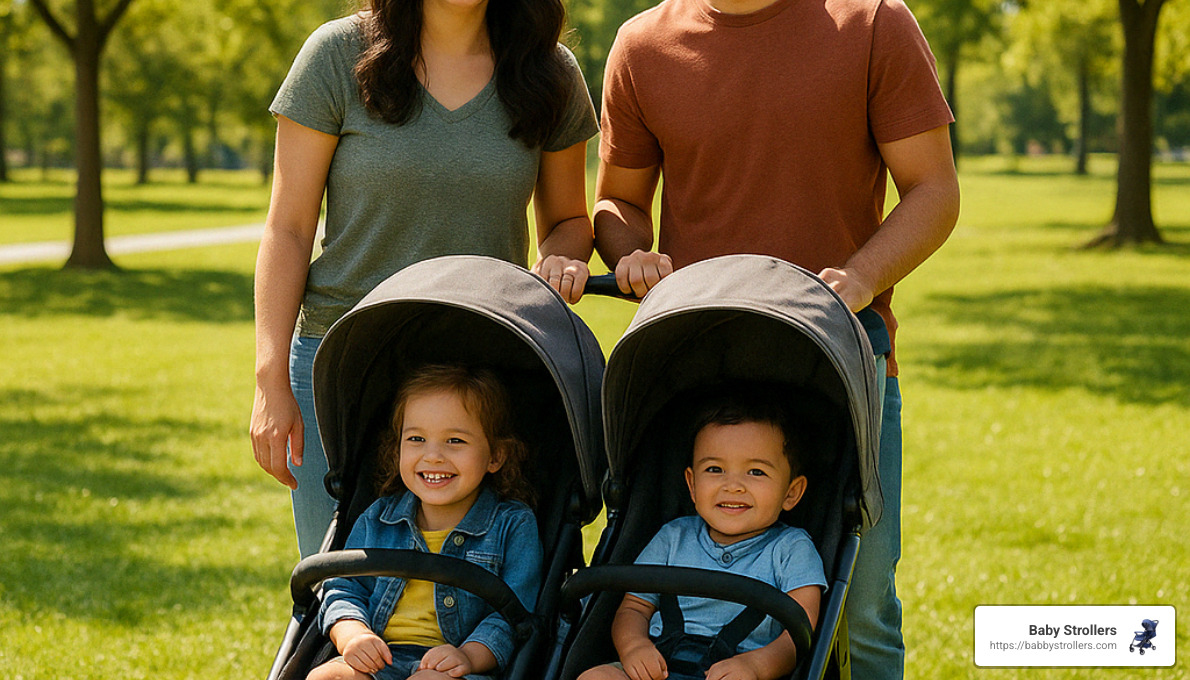
Whew! We’ve covered a lot of ground in this double stroller buying guide, haven’t we? If your head is spinning with wheel sizes and folding mechanisms, don’t worry—that’s completely normal. Choosing the perfect chariot for your little ones is a big decision, but I hope you’re now feeling more confident about which direction to steer.
Magical moment when you find the right stroller? It’s like trying on shoes that fit perfectly—suddenly everything clicks. The handle sits at just the right height, the fold seems intuitive, and you can actually imagine navigating your daily life with this wheeled companion.
Each double stroller type brings something special to the table. Side-by-side models give your children equal views of the world and often handle like a dream. Tandem strollers slip through doorways with ease, perfect for city dwellers navigating tight spaces. Convertible options grow alongside your family, adapting to your changing needs. And those wagon-style models? They’re game-changers for active families who refuse to let having two kids slow them down.
Your lifestyle should be the compass guiding your decision. A jogger who needs all-terrain capabilities has different priorities than a subway-commuting parent who needs something narrow and lightweight. The farmer’s market regular needs ample storage, while the frequent flyer needs something that folds compactly.
What matters most isn’t necessarily getting the most expensive model or the one with the trendiest features—it’s finding the stroller that makes your daily parenting journey smoother. After all, you’ll be pushing this stroller nearly every day, often while juggling coffee, diaper bags, and perhaps a toddler meltdown or two.
I always tell parents to think about their “deal-breakers” versus “nice-to-haves.” Maybe you absolutely need a stroller that fits through your narrow apartment doorway (deal-breaker), but an adjustable handlebar would just be a bonus (nice-to-have). This kind of clarity helps cut through the overwhelm.
At BabbyStrollers.com, we’ve guided thousands of parents through this decision process. We understand that beyond the technical specifications, you’re looking for a trusted companion for some of your family’s most precious moments—first trips to the zoo, neighborhood walks, travel trips, and daily errands.
While a quality double stroller is certainly an investment, it’s one that pays daily dividends in sanity-saving convenience. Many parents tell us their double stroller was among their most-used baby gear items, often lasting through multiple children.
For more specific model recommendations and detailed comparisons, our comprehensive stroller guides dive deeper into each category. Our team of stroller specialists (many of whom are parents themselves) are always happy to answer your questions and provide personalized recommendations based on your unique family situation.
The trip of parenting two little ones is wild, wonderful, and occasionally chaotic—but with the right double stroller by your side, you’ll be ready to roll with whatever comes your way.

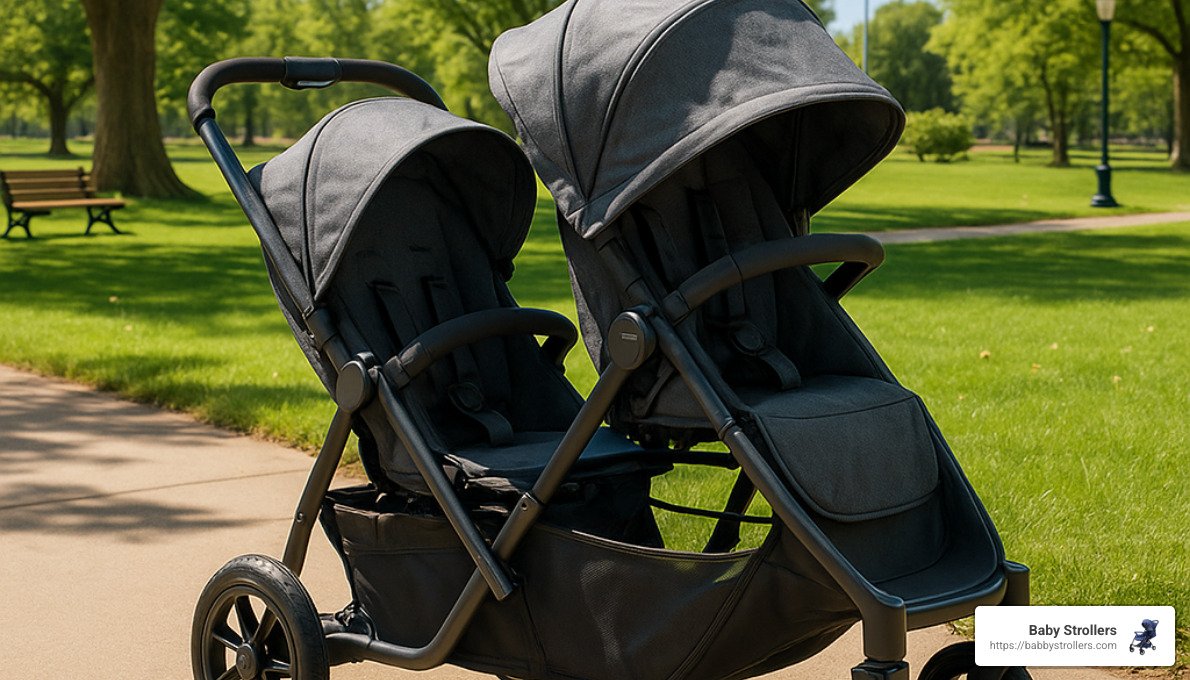

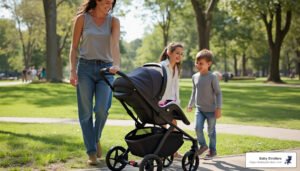
Pingback: Best Tandem Double Strollers 2024: Stress-Free Picks
Pingback: Double Umbrella Stroller: 5 Amazing Benefits for 2025
Pingback: Double Jogging Stroller Comparison: Top 5 Best Picks 2025
Pingback: Compact Double Stroller for Twins: Top 5 Best Picks 2023
Pingback: Double Stroller for Twin Dolls: Top 5 Must-Have Designs
Pingback: Double Stroller for Twins with Car Seats: Top 5 Best in 2025
Pingback: Best Double Strollers: Top 5 Amazing Choices 2025
Pingback: Double Stroller All Terrain: Top 3 Must-Have Choices 2025